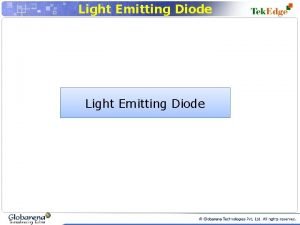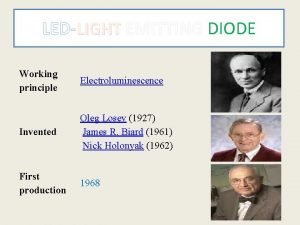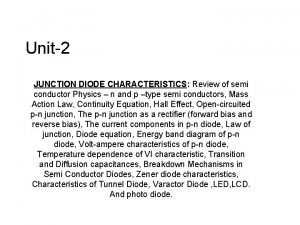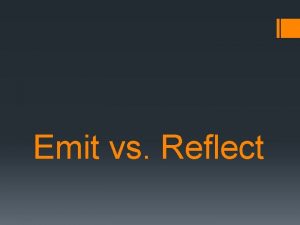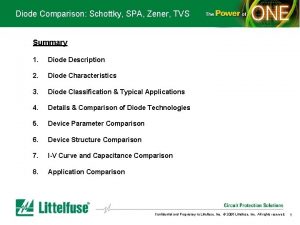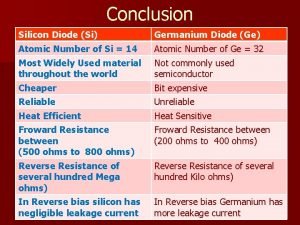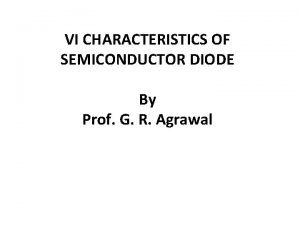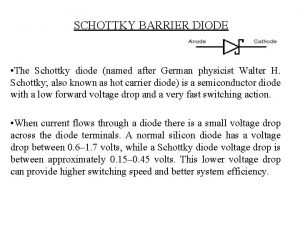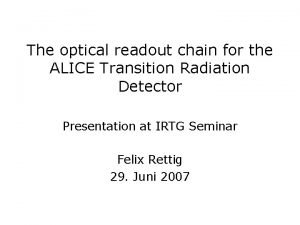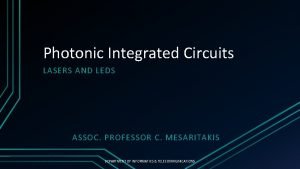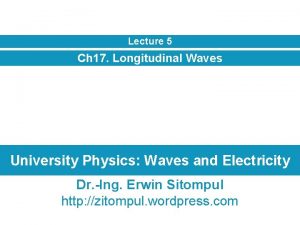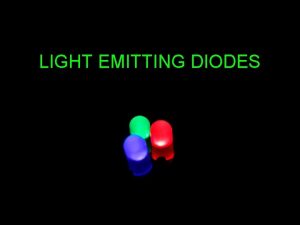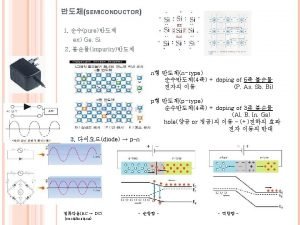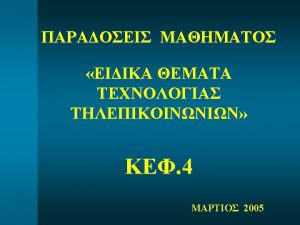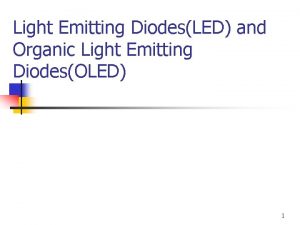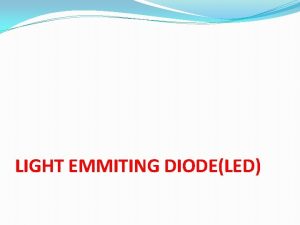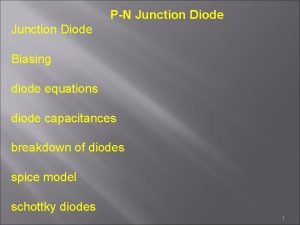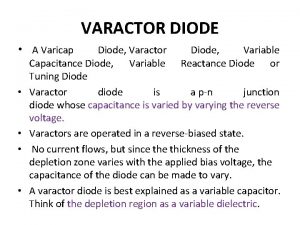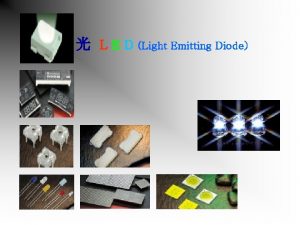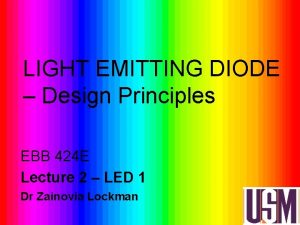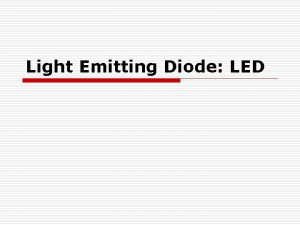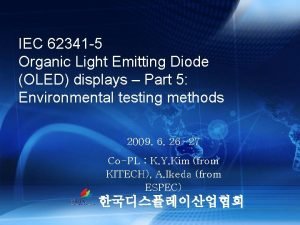Light Emitting Diode Light Emitting Diode In all













- Slides: 13

Light Emitting Diode

Light Emitting Diode ØIn all semiconductor PN diodes, some of the energy is released and given up in the form of heat or in the form of photon. ØIn Silicon and Germanium, greater percentage of realised energy is given up in the form of heat. Symbol Click to view types of LEDs

Light Emitting Diode ØIn Gallium arsenide phosphide, larger fraction of released energy appears in the form of photon or visible light. Then this diode becomes visible light source ØLEDs were introduced during the early 1960 s by Texas Instruments. Today LEDs produce a far brighter light source, are available in a variety of voltages and sizes, and in a range of colours including red, orange, yellow, green, blue and white. Symbol Click to view Symbol

Light Emitting Diode LED: Types Discrete LEDs: These are popular "standard" type manufactured in a small round dome epoxy encapsulation, LEDs are also available in a variety of other shapes and sizes. In particular, rectangular, square and triangular LEDs are available for Panel Indicator applications. Alpha-Numeric Displays: LED displays (comprising 7 or more individual LEDs) were introduced around 1967. Today these displays are found in many electrical appliances and other items. Click to view Alpha. Numeric Displays

Light Emitting Diode LED: Types LED Clusters and Lights: Modern individual LED components are not anywhere near as bright as large incandescent lamps. Therefore, most LED powered lights require a group or cluster of LED devices to create a bright light source. In some applications this is an advantage. Click to view Image

Light Emitting Diode LED: Construction LED Construction The basic LED construction consists of an LED die (this is the semiconductor which emits the light) which is mounted by conductive epoxy and a wire bond onto a lead frame (metal legs) which allows connection of the die to the external power source. Click to view LED Construction

Light Emitting Diode LED: Working LED is based on the principle of electroluminescence. It is a diode that gives off visible light from the depletion region when forward biased. This process of giving off light by applying electrical source of energy is called as electroluminescence. The resistor is always connected in series with LED so as to limit current.

Light Emitting Diode LED: Working Calculating The Current Limiting Resistor: The series resistor can be calculated using a simple formula. R = (Vs - Vf) /If Where: R is the resistor value Vs is the supply voltage Vf is the forward voltage drop Click to view Image

Light Emitting Diode LED: Characteristics When forward voltage is higher than the diode's internal barrier voltage, Vf light is displayed. LEDs pass current in the forward direction, but block current in the reverse direction. This means the LED will only light up if connected with its cathode on the negative side of the circuit, and its anode on the positive side. Too much reverse voltage will destroy LEDs and diodes. Click to view Image

Light Emitting Diode LED: Advantages ØEfficiency : LED produce more light per watt compared to bulbs Ø Size : They come in variety of sizes and shapes. The LED region may be from 0. 1 to 1 inch in length. Small size and weight. Ø Power consumption: Low power consumption Ø Lifetime : Lifetime is high exceeding 106 hours - long life Ø On-Off time : Very fast action. LEDs light up very quickly. A typical red indicator LED will achieve full brightness in under a microsecond. LEDs used in communications devices can have even faster response times.

Light Emitting Diode LED: Advantages Ø Cooling : LED radiate very little heat in the form of radiation that causes damage. Ø Cycling: LEDs are ideal for use in applications that are subject to frequent on-off cycling, unlike fluorescent lamps that burn out more quickly when cycled frequently. Ø Colour: They are available in different colours such as red, green, yellow, orange and white, blue Ø Speed : They have fast response – 1 ns

Light Emitting Diode LED: Applications Traffic light - LED’s are used in traffic light signs because of their high brightness, low maintenance and energy costs, long life , and variety in size. They take shapes of arrows, countdown displays, pedestrian signals. Boards – Boards displayed in §Banks such as bank rates, exchange rates etc §Time and temperature displays §Message displays §Call boards §Destination scrolling displays at airport, railway and buses

Light Emitting Diode LED: Applications ØCalculators ØAviation lighting ØAutomotive lighting ØCommunication and Many more
 Construction of light emitting diode
Construction of light emitting diode Diode works on the principle of electroluminescence
Diode works on the principle of electroluminescence Characteristics of semi conductor
Characteristics of semi conductor Emit and reflect
Emit and reflect Zener vs tvs
Zener vs tvs V-i characteristics of silicon and germanium diodes
V-i characteristics of silicon and germanium diodes Tunnel diode v-i characteristics
Tunnel diode v-i characteristics Diode i-v characteristics
Diode i-v characteristics Vertical cavity surface emitting laser
Vertical cavity surface emitting laser Laser coherence
Laser coherence An ambulance with a siren emitting a whine at
An ambulance with a siren emitting a whine at Name three lines
Name three lines Light light light chapter 23
Light light light chapter 23 Into the light chapter 22
Into the light chapter 22
